Chef Hung Beef Noodle Soup Vancouver
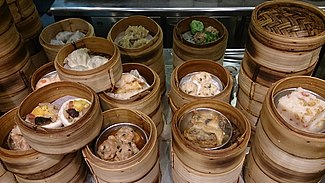
Dim sum (traditional Chinese: 點心; simplified Chinese: 点心; pinyin: diǎnxīn ; Cantonese Yale: dímsām ) is a large range of small Chinese dishes that are traditionally enjoyed in restaurants for brunch.[1] [2] Most modern dim sum dishes originated in China and are normally associated with Cantonese cuisine, although dim sum dishes also be in other Chinese cuisines. In the tenth century, when the city of Guangzhou (Canton) began to feel an increment in commercial travel,[3] many frequented teahouses for small-portion meals with tea called yum cha, or "drinkable tea" meals.[iv] [3] [five] Yum cha includes ii related concepts.[half dozen] The get-go is "yat jung leung gin" (一盅兩件), which translates literally every bit "1 loving cup, two pieces". This refers to the custom of serving teahouse customers two pieces of delicately made food items, savory or sugariness, to complement their tea. The second is dim sum (點心) and translates literally to "touching heart", the term used to designate the modest food items that accompanied the tea drinking.
Teahouse owners gradually added various snacks called "dim sum" to their offerings. The exercise of having tea with dim sum eventually evolved into the modern yum cha (brunch).[3] [vii] Cantonese dim sum culture developed speedily during the latter half of the nineteenth century in Guangzhou.[8] Cantonese dim sum was based originally on local foods.[8] Equally dim sum continued to develop, chefs introduced influences and traditions from other regions of China.[8]
There are over grand dim sum dishes in existence today.[9] [8] Some estimates merits that there are at least two thousand types of dim sum, though simply about fifty or then are commonly sold exterior of China.[x] Cantonese dim sum has a very broad range of flavors, textures, cooking styles and ingredients,[viii] and tin can be classified into regular items, seasonal offerings, weekly specials, banquet dishes, vacation dishes, house signature dishes, travel-friendly, as well every bit breakfast or lunch foods and late nighttime snacks.[viii]
Dim sum restaurants typically accept a broad variety of dishes, usually totaling several dozen.[11] [12] The tea is very important, only every bit of import as the food.[thirteen] [14] Many Cantonese restaurants serve dim sum every bit early equally five in the morning,[fifteen] [sixteen] while more traditional restaurants typically serve dim sum until mid-afternoon.[15] [17] [eighteen] Dim sum restaurants have a unique serving method where servers offer dishes to customers from steam-heated carts.[9] [nineteen] [20] It is now commonplace for restaurants to serve dim sum at dinner fourth dimension and sell diverse dim sum items a la carte du jour for takeout.[21] In add-on to traditional dim sum, some chefs also create and prepare new fusion-based dim sum dishes.[22] [23] [24] [25] At that place are variations designed for visual entreatment on social media, such as dumplings and buns fabricated to resemble animals, that also exist.[26] [27]
Etymology [edit]
The original significant of the term dim sum remains unclear and contested.[28] Some references state that the term originated in the Eastern Jin dynasty (317 Ad–420 AD).[29] [xxx] According to one fable, to testify soldiers gratitude after battles, a general had civilians make buns and cakes to send to the front lines. "Gratitude", or 點點心意; diǎn diǎn xīnyì , afterward shortened to 點心 diǎn xīn, of which dim sum is the Cantonese pronunciation, came to represent dishes made in a like way.
Some versions date the legend to the Southern Song dynasty (960–1279)< after the term's earliest attestation in the Book of Tang (唐書; Táng shū .[xxx] Written in the V Dynasties and 10 Kingdoms period (907–979), the volume uses dim sum as a verb instead:「治妝未畢, 我未及餐, 爾且可點心」; "Zhì zhuāng wèi bì, wǒ wèi jí cān, ěr qiě kě diǎnxīn" , which translates to: "I have not finished preparing myself and ready for a proper meal, therefore you can treat yourself with some small snacks."[30] In this context, dim sum (點心; 'to lightly touch (your) center'), means "to barely fill (your) breadbasket".[30] Dim sum dishes are normally associated with yum cha (Chinese: 飲茶; Cantonese Yale: yám chàh ; pinyin: yǐnchá ; lit. 'drink tea'), a Cantonese brunch tradition.[31] [32] Chinese food historian Yan-kit So has described dim sum as:[33] [2]
Literally translated as 'and so shut to the heart', they are, in reality, a big range of hors d'oeuvres Cantonese people traditionally enjoy in restaurants (previously teahouses) for breakfast and for lunch, merely never for dinner, done downwards with tea. 'Let's go yum cha (to drink tea)' is understood among the Cantonese to hateful going to a eating house for dim sum; such is the twin linkage between the food and the beverage.
Cuisine [edit]
There are over thou dim sum dishes available,[8] [9] [34] which are usually eaten as breakfast or brunch.[17] [xviii] Cantonese dim sum has a very wide range of flavors, textures, cooking styles, and ingredients,[8] and tin be classified into regular items, seasonal offerings, weekly specials, banquet dishes, vacation dishes, house signature dishes, travel-friendly, too every bit breakfast or lunch foods and late night snacks.[viii]
The subtropical climate of the southeast quadrant of Guangdong partly influences dim sum'southward portion size.[viii] Information technology tin cause a subtract in appetite,[35] so that people prefer eating scaled-downward meals throughout the mean solar day rather than the customary three large meals.[viii] Teahouses in Guangzhou served "three teas and two meals", which included lunch and dinner, and breakfast, afternoon and evening teas with dim sum.[8]
Many dim sum dishes are made of seafood, chopped meats, or vegetables wrapped in dough or thin wrappings and steamed, deep-fried, or pan-fried.[36] [nine] [37] A traditional dim sum brunch includes various types of steamed buns, such as cha siu bao (a steamed bun filled with barbecue pork), rice or wheat dumplings, and rice noodle rolls that contain a range of ingredients, including beef, chicken, pork, prawns and vegetarian options.[38] [39] Many dim sum restaurants besides offer plates of steamed light-green vegetables, blimp eggplant, stuffed green peppers, roasted meats, congee and other soups.[40] Dessert dim sum is as well bachelor and can be ordered at whatever time since there is not a fix sequence for the meal.[41] [42]
It is customary to order "family-manner", sharing the small dishes consisting of 3 or four pieces of dim sum among all members of the dining party.[17] [xviii] [43] [42] Small-scale portion sizes allow people to try a broad variety of food.[18]
Dishes [edit]
Dim sum restaurants typically have a wide variety of dishes, usually several dozen.[xi] [12]
Dumplings [edit]
| Name | Epitome | Chinese | Clarification |
|---|---|---|---|
| Shrimp dumpling |  | ( 蝦餃 ) | steamed dumpling with shrimp filling. [44] |
| Teochew dumpling | 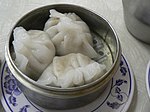 | (潮州粉粿; cháozhōu fěnguǒ ; Chìu jāu fán gwó ) | steamed dumpling with peanuts, garlic, Chinese chives, pork, dried shrimp, and Chinese mushrooms.[45] |
| Chive dumpling |  | (韭菜餃) | steamed dumpling with Chinese chives.[46] |
| Xiaolongbao |  | 小笼包; 小籠包; xiǎolóngbāo ; síu lùhng bāau | dumplings containing a rich broth and filled with meat or seafood.[47] |
| Guotie |  | 鍋貼; guōtiē ; wōtip | pan-fried dumpling, usually with meat and cabbage filling.[48] [49] |
| Shumai |  | 烧卖; 燒賣; shāomài ; sīu máai | steamed dumplings with pork and prawns, normally topped off with crab roe and mushroom.[50] |
| Taro dumpling |  | 芋角; yù jiǎo ; wuh gok | deep fried dumpling made with mashed taro and stuffed with diced mushrooms, shrimp and pork.[51] |
| Haam Seui Gok | 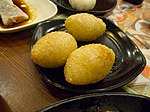 | 鹹水角; xiánshuǐ jiǎo ; hàahm séui gok | deep fried dumpling with a slightly savory filling of pork and chopped vegetables in a sweet and sticky wrapping.[52] |
| Dumpling soup |  | 灌湯餃; guàntāng jiǎo ; guntōng gáau | soup with one or two big dumplings.[53] |
| Wonton | 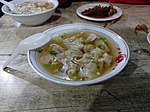 | Chinese: 雲吞 | dumpling filled with ground pork and shrimp |
Rolls [edit]
| Name | Paradigm | Chinese | Clarification |
|---|---|---|---|
| Jump roll |  | 春卷; 春捲; chūnjuǎn ; chēun gyún | a deep fried roll with diverse sliced vegetables (such as carrots, cabbage, mushroom and forest ear fungus) and sometimes meat.[54] |
| Tofu pare ringlet |  | 腐皮捲; fǔpíjuǎn ; fuh pèih gyún | a scroll fabricated of tofu peel filled with diverse meats and sliced vegetables.[55] |
| Fresh bamboo curl | 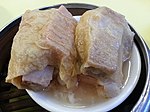 | 鮮竹卷 | a roll made of tofu peel filled with minced pork and bamboo shoot, typically served in an oyster sauce broth.[56] |
| Four-treasure chicken gyre | 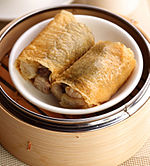 | 四寶雞扎 | a whorl made of tofu peel filled with chicken, Jinhua ham, fish maw (花膠) and Chinese mushroom.[57] |
| Rice noodle gyre |  | 腸粉; chángfěn ; chéungfán | steamed rice noodles with or without meat or vegetable filling. Popular fillings include: beef, dough fritter, shrimp and barbecued pork. Oftentimes served with sweetened soy sauce.[58] [59] |
| Zhaliang |  | 炸兩; jaléung | steamed rice noodles rolled around youjagwai (油炸鬼), typically doused in soy sauce, hoisin sauce, or sesame paste and sprinkled with sesame seeds.[sixty] |
Buns [edit]
| Name | Epitome | Chinese | Clarification |
|---|---|---|---|
| Barbecued pork bun |   | (叉燒包; chāshāo bāo ; chāsīu bāau ) | bun with barbecued pork filling steamed to be white and fluffy. 叉燒餐包; chāshāo cān bāo ; chāsīu chāan bāau is a variant that is glazed and baked for a golden appearance.[61] |
| Sweet cream bun | 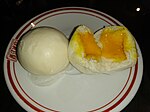 | (奶黃包; nǎihuáng bāo ; náaih wòhng bāau ) | steamed bun with milk custard filling.[62] |
| Lotus seed bun | 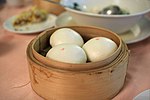 | (蓮蓉包) | steamed bun with lotus seed paste filling.[63] |
| Pineapple bun |  | (菠蘿包; bōluó bāo ; bōlòh bāau ) | a usually sweet breadstuff roll that does non contain pineapple but has a topping textured like pineapple skin.[64] |
Cakes [edit]
| Proper name | Epitome | Chinese | Clarification |
|---|---|---|---|
| Turnip cake |  | 蘿蔔糕; luóbo gāo ; lòh baahk gōu | pudding made from a mix of shredded white radish, $.25 of dried shrimp, Chinese sausage and mushroom that is steamed, sliced, and pan-fried.[65] [66] |
| Taro cake | 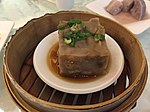 | 芋頭糕; yùtou gāo ; wuh táu gōu | pudding made of taro.[67] |
| Water chestnut block |  | 馬蹄糕; mǎtí gāo ; máh tàih gōu | pudding made of crispy water chestnut; some restaurants likewise serve a variation fabricated with bamboo juice.[68] |
| Nian gao |  | 年糕 | glutinous rice flour cake sweetened, usually with brown sugar. [69] |
Meats [edit]
| Name | Image | Chinese | Description |
|---|---|---|---|
| Steamed meatball |  | 牛肉丸; niúròu wán ; ngàuh yuhk yún | steamed meatballs served on thin tofu pare.[70] |
| Phoenix claws |  | 鳳爪; fèngzhuǎ ; fuhng jáau | deep fried, boiled, and and so steamed chicken feet with douchi. "White Deject Phoenix Claws" (白雲鳳爪; báiyún fèngzhuǎ ; baahk wàhn fuhng jáau ) is a plainly steamed version.[71] [72] |
| Spare ribs |  | 排骨; páigǔ ; pàaih gwāt | steamed pork spare ribs with douchi and sometimes garlic and chili.[73] |
| Pork rinds, radish and fish assurance |  | 豬皮、蘿蔔、魚丸 | boiled and steamed pork rind, radish and fish balls in curry.[74] |
| Pork blood |  | 豬紅 | stir-fried pork blood with douchi and scallion.[75] |
| Beefiness tendon |  | 牛筋 | [76] |
| Reticulum beefiness tripe |  | 金錢肚 [77] | |
| Omasum beef tripe |  | 牛百葉 (牛柏葉)[78] | |
| Beef entrails |  | 牛雜 (牛什) | pieces of beefiness entrails such equally tripe, pancreas, intestine, spleen and lung served in a bowl of master stock.[79] |
| Siu mei |  | 燒味; shāowèi ; sīuméi | Hong Kong-mode barbecue meat roasted in an oven. Pop varieties include char siu (叉燒), siu ngo (Roast goose) (燒鵝), siu aap (duck) (燒鴨), white cut craven (白切雞), soy sauce chicken (豉油雞) and siu yuk (roast meat) (燒肉).[80] |
| Craven wing |  | 雞翅 (雞翼) | deep fried (炸雞翼, 炸雞翼)[81] or marinated in soy sauce and spices (瑞士雞翅, 瑞士雞翼).[82] |
Seafood [edit]
- Deep fried squid (炸鱿鱼须; 炸魷魚鬚; zhàyóuyúxū ; ja yàuh yùh sōu ): like to fried calamari, the dilapidated squid is deep-fried.[83]
- Curry squid (咖哩鱿鱼; 咖哩魷魚): squid served in back-scratch broth.[84]
Vegetables [edit]
- Steamed vegetables (油菜; yóucài ; yáu choi ): served with oyster sauce, popular varieties include lettuce (生菜; shēngcài ; sāang choi ), choy sum (菜心; càixīn ; choi sām ), gai lan (芥兰; 芥蘭; jièlán ; gaailàahn ), or h2o spinach (蕹菜; wèngcài ; ung choi ).[85]
- Fried tofu (炸豆腐): deep fried tofu with salt and pepper.[86]
Rice [edit]
| Name | Image | Chinese | Description |
|---|---|---|---|
| Lotus leaf rice | 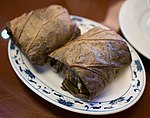 | 糯米雞; nuòmǐ jī ; noh máih gāi | mucilaginous rice wrapped in a lotus foliage that typically contains egg yolk, dried scallop, mushroom and meat (ordinarily pork and chicken). A lighter variant is known equally "pearl chicken" (珍珠雞; zhēnzhū jī ; jānjyū gāi ).[87] |
| Chinese gluey rice |  | 糯米飯; nuòmǐ fàn ; noh máih faahn | stir fried (or steamed) glutinous rice with Chinese sausage, soy sauce steeped mushrooms, sweet spring onions and sometimes chicken marinated with a mixture of spices including five-spice powder.[88] [89] [90] |
| Congee | 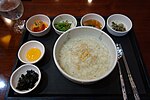 | 粥; zhōu ; jūk | many kinds of rice porridge, such every bit the "Preserved Egg and Pork Porridge" (皮蛋瘦肉粥; pídàn shòuròu zhōu ; pèihdáan sauyuhk jūk ).[91] |
Desserts [edit]
| Name | Paradigm | Chinese | Description |
|---|---|---|---|
| Egg tart | 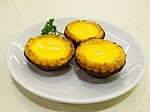 | Chinese: 蛋撻; pinyin: dàntǎ ; Cantonese Yale: daahn tāat | broiled tart with egg custard filling.[92] [93] [94] |
| Douhua |  | 豆腐花; dòufuhuā ; dauh fuh fā | soft tofu served with a sweet ginger or jasmine syrup.[95] [96] |
| Sesame ball |  | 煎堆; jiānduī ; jīn dēui ) | deep fried chewy dough with diverse fillings (lotus seed, black bean, red bean pastes) coated in sesame seeds.[97] [98] |
| M-layer block |  | 千層糕; qiāncéng gāo ; chīnchàhng gōu | a dessert fabricated of many layers of salted egg dough.[99] |
| Malay sponge cake | 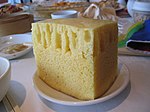 | 馬拉糕; mǎlā gāo ; máhlāai gōu | sponge cake consisting of lard or butter, flour, and eggs.[100] |
| White saccharide sponge cake |  | 白糖糕; báitáng gāo ; baahk tòng gōu | steamed sponge cake made with white saccharide.[101] [102] |
| Coconut pudding |  | 椰汁糕; yézhī gāo ; yèh jāp gōu | calorie-free and spongy but creamy coconut milk pudding made with a thin clear jelly layer made with coconut water on acme.[103] |
| Mango pudding |  | 芒果布甸; mángguǒ bùdiàn ; mōnggwó boudīn | a sweetness, rich mango pudding frequently served with a topping of evaporated milk and large chunks of fresh mango.[104] |
| Ox-natural language pastry | 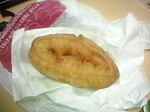 | 牛脷酥 | a fried oval-shaped dough resembling an ox natural language that is similar to youjagwai, just sugar is added to the flour.[105] |
| Tong sui |  | (糖水) | sweet dessert soups; popular varieties include black sesame soup (芝麻糊), red bean soup (紅豆沙), mung bean soup (綠豆沙), sai mai lo (西米露), guilinggao (龜苓膏), peanut paste soup (花生糊) and walnut soup (核桃糊). |
Tea [edit]

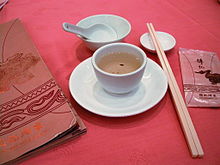
Tea is considered to exist very important, and then much then that it is considered just as important as the food itself.[13] [14] Teas served during dim sum include:
- Chrysanthemum tea: instead of tea leaves, it is a flower-based tisane (herbal tea) made from flowers of the species Chrysanthemum morifolium or Chrysanthemum indicum, which are the most popular in East Asia.[106] To prepare the tea, chrysanthemum flowers (usually dried) are steeped in hot water (normally xc to 95 °C (194 to 203 °F) after cooling from a boil) in a teapot, cup, or drinking glass. A mutual mix with pu-erh is called guk pou (Chinese: 菊普; pinyin: jú pǔ ; Cantonese Yale: gūk póu ) from its component teas.
- Green tea: freshly picked leaves that go through heating and drying processes but not oxidation, and so keep their original green color and chemic compounds, similar polyphenols and chlorophyll.[107] Produced all over China, and the most popular category of tea, greenish teas include the representative Dragon Well (Chinese: 龍井; pinyin: lóngjǐng ; Cantonese Yale: lùhngjéng ) and Biluochun from Zhejiang and Jiangsu provinces, respectively.
- Oolong tea: partially oxidizing the tea leaves imparts them with characteristics of both green and black teas.[108] [109] [110] Oolong teas are shut in taste to green than blackness tea, even so accept less of a "grassy" taste. Major oolong-tea producing areas such equally Fujian, Guangdong, and Taiwan line the southeastern coast of People's republic of china. Tieguanyin or Ti Kuan Yin (Chinese: 鐵觀音; pinyin: tiěguānyīn ; Cantonese Yale: titgūnyām ): one of the about popular, originated in Fujian province and is a premium variety with a delightful fragrance.
- Pounei (Cantonese) or pu-erh tea (Mandarin): usually a compressed tea, pu-erh has unique, earthy notes derived from years of fermentation.[111] [112]
- Scented teas: various mixes of flowers with green, blackness, or oolong teas exist. Flowers used include jasmine, gardenia, magnolia, grapefruit blossom, sweet-scented osmanthus and rose. Strict rules govern the proportion of flowers to tea. Jasmine tea, the well-nigh popular scented tea, is the one most often served at yum cha establishments.
The tea service includes several customs.[113] [114] [115] [116] Typically, the server starts by request diners which tea to serve. Co-ordinate to etiquette, the person closest to the tea pot pours tea for the others. Sometimes, a younger person will serve an older person. Those receiving tea express thank you past tapping their index and middle fingers twice on the table.[43] [116] Diners flip open the hat (of hinged metal tea pots) or offset the tea pot cover (on ceramic tea pots) to point an empty pot; servers will then refill the pot.[39] [116]
History [edit]

Dim sum is office of the Chinese tradition of snacks originating from the Song Dynasty (960-1279), when regal chefs created various dishes such as minced pheasant, distraction natural language, and desserts fabricated from steamed milk and edible bean paste.[34] Guangzhou experienced an increase in commercial travel in the 10th century[3] At that time, travelers would frequent teahouses for small-portion meals with tea called yum cha, or "beverage tea" meals.[4] [iii] [v] Yum cha includes ii related concepts. The get-go, 一盅兩件, translates literally every bit "one cup, two pieces". This refers to the custom of serving teahouse customers ii pieces of delicately made nutrient items, savory or sweet, to complement their tea. The 2d, 點心, which means "dim sum" translates literally to "touching heart" (i.e. center touching). This is the term used to designate the small food items that accompanied the drinking of tea.[six] During the thirteenth century, when Mongols invaded Red china, the royal court fled to southern Mainland china, bringing a royal influence to the dim sum of Guangzhou.[34] Guangzhou was a wealthy, large port metropolis that had international visitors, a temperate climate, and a coastline where fresh and tropical ingredients were grown, resulting in an ideal environment for food and amusement.[34] In Guangzhou, street vendors and teahouses sold dim sum.[34] The practice of having tea with dim sum at tea houses eventually evolved into modern yum cha.[3] [vii] While at the teahouses, travelers selected their preferred snacks from carts.[3] Visitors to tea houses frequently socialized every bit they ate and business concern people negotiated deals over dim sum.[3]
During the Ming Dynasty (1368 - 1644), the Tea and Horses Bureau was established to monitor tea production and improve tea quality.[34] The improvements in tea quality also led to teahouse improvements.[34]
Cantonese dim sum culture developed rapidly during the latter half of the nineteenth century in Guangzhou.[eight] Teahouse dining areas were typically located upstairs and initial dim sum fare included steamed buns.[8] Eventually, these evolved into specialized dim sum restaurants; the diversity and quality of dim sum dishes rapidly followed suit.[8] Cantonese dim sum was originally based on local foods such every bit sweet roast pork called char siu and fresh rice noodles.[eight] As dim sum continued to develop, chefs introduced influences and traditions from other regions of Red china, which created a starting point for the wide variety of dim sum bachelor today.[8] Chefs created a large range of dim sum that even today comprises most of a teahouse'south dim sum offerings.[viii] Part of this development included reducing portion sizes of larger dishes originally from northern Cathay, such as stuffed steamed buns, so they could hands be incorporated into the dim sum menu.[8] The rapid growth in dim sum restaurants was due partly because people establish the preparation of dim sum dishes to exist time-consuming and preferred the convenience of dining out and eating a big variety of broiled, steamed, pan-fried, deep-fried, and braised foods.[8] Dim sum continued to develop and likewise spread southward to Hong Kong.[117]
Although dim sum is normally considered Cantonese, it includes many boosted influences.[8] Over thousands of years, as people in China migrated in search of different places to alive, they carried the recipes of their favorite foods and continued to fix and serve these dishes.[8] Many Han Chinese migrated south seeking warmer climates.[viii] Settlements took shape in the Yangtze River Valley, the central highlands, and the littoral southeast, including Guangdong.[8] The influence of Suzhou and Hangzhou is found in vegetarian soy skin rolls and pearl meatballs. The dessert squares flavored with red dates or wolfberries are influences from Beijing desserts.[8] Savory dishes, such as pot stickers and steamed dumplings, include Muslim influences considering of people traveling from Central Asia across the Silk Road and into Guangdong.[viii] These are only a few examples of how a wide range of influences became incorporated into traditional Cantonese dim sum.[eight]
By 1860, strange influences had to shape Guangdong's dim sum with culinary innovations such as ketchup, Worcestershire sauce, and back-scratch, all of which came to be used in some savory dishes.[8] Custard pies evolved into the miniature classics found in every teahouse.[8] Other dim sum dishes evolved from Indian samosas, mango puddings and Mexican conchas (snowfall-topped buns).[8] Cantonese-style dim sum has an extremely wide range of tastes, textures, cooking styles, and ingredients.[eight] Equally a outcome, there are more than a thousand different varieties of dim sum.[8]
During the 1920s, in Guangzhou, the foremost places to enjoy tea were its tea pavilions, which had refined and expansive surroundings.[eight] The customers were wealthy, and in that location were rather high standards for the privilege of enjoying tea pavilion service and dim sum.[viii] Upon entering a tea pavilion, customers would audit tea leaves to ensure their quality and to verify the water temperature.[8] Once satisfied, these guests were presented with a pencil and a booklet list the available dim sum.[8] A waiter would then tear their orders out of the booklet then that the kitchen could pan-fry, steam, broil or deep-fry these dishes on demand.[8] Customers dined upstairs in privacy and comfort.[8] Servers carefully balanced the dishes on their arms or arranged them on trays as they climbed up and down the stairs.[8] Eventually, dim sum carts were used to serve the steamers and plates.[8]
People with average incomes also enjoyed tea and dim sum.[8] Early every morn, customers visited cheap restaurants that offered filled steamed buns and hot tea.[8] During the mid-morn, students and regime employees ordered two or three kinds of dim sum and ate equally they read their newspapers.[8] In the late forenoon, people working at small businesses visited restaurants for breakfast and to apply the eating place as a small office space.[8]
Past the tardily 1930s, Guangzhou's teahouse culture included 4 high-contour dim sum chefs, with signs at the front doors of their restaurants.[viii] There was heavy contest among teahouses and as a effect, new varieties of dim sum were invented almost daily, including dishes influenced by the tea pastries of Shanghai and Beijing, and the Western world.[viii] Many new fusion dishes were also created, including puddings, broiled rolls, turnovers, custard tarts, and Malay steamed cakes.[viii]
There were likewise pregnant increases in the variety of thin wrappers used in both sweet and savory items:[8]
If we concentrate but on the changes and development in the diversity of 'wrappers', the primary types of dim sum wrappers during the 1920s included such things every bit raised (for filled buns), wheat starch, shao mai (i.e., egg dough), crystal bun, crispy batter, sticky rice, and boiled dumpling wrappers. By the 1930s, the varieties of wrappers normally used by chefs included... puff pastry, Cantonese short pastry, [and so on, for a full of 23 types] that were prepared by pan-frying, deep-frying, steaming, blistering, and roasting.[8] [118]
As the Chinese Civil War progressed from 1927 to 1949, many dim sum chefs left China and settled in Hong Kong, resulting in further refinements and innovation of the dim sum in that location.[34] Very large dim sum restaurants in major cities like Hong Kong, San Francisco, Boston, Toronto, and New York were also established.[34]
In the nineteenth century, Cantonese immigrants brought dim sum to the W and E coasts of the United States.[119] Some of the earliest dim sum restaurants in the U.S. still operating today opened in 1920 in San Francisco and New York Urban center.[120] [121] The Chinese history in San Francisco is believed to take started most 30 years before the restaurant was opened. The Chinese preferred to alive in the nowadays Chinatown area because of its restaurants and theaters.[120] In the late 1930s, some early U.S. newspaper references to dim sum began to announced. While some Chinese restaurants in the U.Due south. had offered dim sum for decades, it was not until the late 1980s when there was a broader public awareness of dim sum.[3]
Although there was increased awareness of dim sum, ane chef from Hong Kong, who immigrated to San Francisco, noted that diners in the U.S. normally focused on the food itself, and not the communal aspects of eating dim sum.[122] Although dim sum is a Chinese repast, it is a communal dining and social experience that can span hours.[122] Information technology is customary for large groups to enjoy dishes together as a leisurely social activity.[122] Diners get to restaurants early, around 10:00 AM, and rather than ordering a whole table of food, they social club pocket-sized amounts, take a cup of tea, read the newspaper, and wait for friends and family to join them.[122] As a result, a visit to a dim sum restaurant tin can last from the late morning well into the afternoon.[122] For some people in Hong Kong, dim sum is a daily routine and a style of life.[122] Since this dim sum tradition was not always present in some U.Due south. dim sum restaurants, still, approaches to generate interest and attract customers include customized seasoning and flavors of traditional dishes, as well as creating novel dishes with an emphasis on enhanced flavors and visual appeal.[122]
One nutrient reviewer notes that there has been increased popularity in posting dim sum photos on social media feeds, and that dim sum has become so pop that every U.S. land has come to have at least one loftier-quality dim sum restaurant.[123] At that place is a restaurant, bar, and highly rated dance club complex in Las Vegas, NV, that features high-end Cantonese food (including dim sum), craft cocktails, dinner parties and prominent disc jockeys in a chichi setting.[124] [125] [126] [127]
The dim sum restaurants in Chicago have been serving mainly traditional dim sum in Chinatown, only there has been contempo growth in contemporary dim sum with new fusion dishes, as well as restaurants now located outside Chinatown.[128]
In Hong Kong, many chefs are besides introducing variants based on traditional Cantonese cuisine, which generates interest and provides both Hongkongers and tourists with new, fresh dim sum dishes.[129]
Modern dim sum [edit]
In add-on to traditional dim sum, some chefs too create and set up new fusion-based dim sum dishes.[22] [23] [24] [25] [130] [128] [131] [132] Modernistic versions of buns include pork abdomen steamed buns with cucumber, green onion, cilantro, and ginger hoisin sauce, cocoa mushroom buns, chili lamb buns. Dumplings include snow pea shoot and shrimp dumplings, and chili crab with fried garlic, siu mai with pork, shrimp, scallop, and caviar, dumplings stuffed with shrimp and peanut, dumplings with South Australian scallop, garoupa (grouper), caviar, gold leafage, and egg white, and bone marrow or beefiness short ribs in potstickers. Pastry puff dishes include Australian Wagyu beefiness puff, Assam curry chicken puff, pumpkin puffs. Toast dishes include Hong Kong style French toast with condensed milk and peanut butter and prawn toast. Additional examples are spring rolls filled with caprine animal and duck skin and duck hearts cooked over a woods-fired grill and served with sesame-horseradish sauce.
One AAA 4 diamond award-winning Chinese eatery in Miami Embankment has a prix-fixe dim sum menu, prix-fixe yum cha menu and breakfast cocktails.[133] Variations designed for visual appeal on social media, such every bit dumplings and buns made to resemble animals and fictional characters, also exist.[26] [27] [134] Dim sum chefs have previously used cocoa pulverisation as coloring to create steamed bread puffs to announced like forest mushrooms, espresso powder every bit both flavoring and coloring for deep-fried riblets, also as pastry cream, and French puffs to create innovative dishes while paying tribute to the history of dim sum.[8]
Fast food [edit]
Dim sum can often be purchased from grocery stores in major cities.[113] They can be cooked easily past steaming, frying, or microwaving.[135] [136] Major grocery stores in Hong Kong, Vietnam, the Philippines, Singapore, Taiwan, Mainland china, Indonesia, Malaysia, Brunei, Thailand, Australia,[137] the United States[138] [139] and Canada[140] stock a variety of frozen or fresh dim sum. These include dumplings, Shumai, pork buns, and others.[138]
In Hong Kong and other cities in Asia, dim sum can be purchased from convenience stores, coffee shops and other eateries.[141] [142] Halal-certified dim sum that uses chicken instead of pork is very popular in Hong Kong,[143] Malaysia,[144] Indonesia[145] and Brunei.[146]
-

Streetside dim sum food shop in Hong Kong
-

Frozen dim sum in a grocery store in the United States
-

Limited Dim sum Food truck, Canada Place, Vancouver, BC.
Restaurants [edit]

A light blueish bill card (upper left) on a tabular array of traditional family-style dim sum dejeuner dishes in a restaurant
Some Cantonese restaurants serve dim sum as early as 5 in the morning,[xvi] while more than traditional restaurants typically serve dim sum from mid-morning until mid-afternoon.[xv] [17] [18] Information technology is common for restaurants to serve dim sum during dinner too as for takeout.[21]
Dim sum is served using a unique serving method[19] whereby servers offering dishes to customers from carts, including some carts that are steam-heated.[9] [19] [20] Diners frequently prefer tables nearest the kitchen since servers and carts pass by these tables kickoff.[42] Many restaurants place lazy susans on tables to help diners attain food and tea.[147]
The pricing of dishes at these types of restaurants may vary, simply traditionally they are classified as "small", "medium", "large", "extra-large", or "special".[41] Servers record orders with a condom stamp or an ink pen on a bill menu that remains on the table.[113] [38] [36] Servers in some restaurants utilise distinctive stamps to runway sales statistics for each server.[ citation needed ] When they have finished eating, the customer calls the server over, and their beak is calculated based on the number of stamps or quantities marked in each priced department.[34] [38] [148]
Another manner of pricing the food that was consumed uses the number and color of the dishes left on the table.[eight] [34] Some restaurants offer a new arroyo by using a conveyor belt format.[149]
Other Cantonese restaurants may take orders from a pre-printed sheet of paper and serve à la carte, much similar Castilian tapas restaurants,[150] [151] to provide fresh, cooked-to-lodge dim sum or because of real estate and resource constraints.[152] [153]

Dim sum nutrient shop in Hong Kong
See also [edit]
References [edit]
- ^ Davidson, Alan, 1924-2003 (2014). The Oxford companion to nutrient. Jaine, Tom,, Vannithone, Soun (3rd ed.). New York, NY. ISBN978-0-xix-967733-seven. OCLC 890807357.
{{cite book}}: CS1 maint: multiple names: authors list (link) - ^ a b And so, Yan-kit (April 1997). Classic food of Cathay. London: Macmillan Publishers. ISBN0-333-56907-five. OCLC 32049410.
- ^ a b c d e f grand h i Tribune, Leslie Gourse. "Dim Sum Has Come up a Long Way, From Esoteric to Mass Popularity". chicagotribune.com . Retrieved v Baronial 2020.
- ^ a b Wong, Adele (1 November 2016). Hong Kong Food & Civilisation: From Dim Sum to Dried Abalone. Human being Mo Media. ISBN978-9887756002.
- ^ a b "Fare of the Country; Why Dim Sum Is 'Heart's Please'". The New York Times. 25 October 1981. ISSN 0362-4331. Archived from the original on 4 July 2020. Retrieved 16 August 2020.
- ^ a b "Jian Dui -- Sesame Assurance (煎堆)". Kindred Kitchen. 13 May 2019. Archived from the original on 5 October 2020. Retrieved 14 Baronial 2020.
- ^ a b Parkinson, Rhonda (3 September 2019). "Succulent Dim Sum – Chinese Brunch". About.com-Chinese Food. Archived from the original on 29 March 2013. Retrieved 21 March 2013.
- ^ a b c d e f g h i j yard l m n o p q r s t u v w x y z aa ab ac ad ae af ag ah ai aj ak al am an ao ap aq ar equally at au av aw ax ay Phillips, Carolyn (1 February 2017). "Modern Chinese History equally Reflected in a Teahouse Mirror". Gastronomica. 17 (1): 56–65. doi:10.1525/gfc.2017.17.1.56. ISSN 1529-3262.
- ^ a b c d e Simoons, Frederick J. (1991). Food in China : a cultural and historical inquiry. Boca Raton: CRC Press. ISBN0-8493-8804-X. OCLC 20392910.
- ^ "Why dumplings - the ultimate comfort food - are then popular correct at present". inews.co.uk. 14 Feb 2019. Retrieved xx Apr 2022.
- ^ a b TODAY, Larry Olmsted, special for USA. "Smashing American Bites: Ping'southward serves savory dim sum in NYC's Chinatown". USA TODAY. Archived from the original on four March 2020. Retrieved 16 August 2020.
- ^ a b "A Visual Glossary for Dim Sum!". Dim Sum Guide . Retrieved 23 February 2022.
- ^ a b "Fare of the Country; Why Dim Sum Is 'Heart's Please'". The New York Times. 25 October 1981. ISSN 0362-4331. Archived from the original on four July 2020. Retrieved three July 2020.
- ^ a b Stevenson, Rachel (15 February 2018). "The Platonic Tea Pairing with Dim Sum Guide". Ideal Magazine. Archived from the original on three July 2020. Retrieved three July 2020.
- ^ a b c Jacobs, Harrison. "Here's how to navigate ane of the most epic New York food traditions — 'Dim Sum' in Chinatown". Business Insider. Archived from the original on iii July 2020. Retrieved three July 2020.
- ^ a b 梁廣福. (2015). 再會茶樓歲月 (初版. ed.). 香港: 中華書局(香港)有限公司
- ^ a b c d "How to Order Dim Sum, According to the Head Chef of the First Chinese Eating house in North America to Receive a Michelin Star". Time. Archived from the original on 2 July 2020. Retrieved 3 July 2020.
- ^ a b c d e "Dim Sum". The New York Times. Archived from the original on 5 July 2020. Retrieved iii July 2020.
- ^ a b c Phillips, C. (2016). The Dim Sum Field Guide: A Taxonomy of Dumplings, Buns, Meats, Sweets, and Other Specialties of the Chinese Teahouse. Ten Speed Press. pp. v–6. ISBN978-i-60774-956-1. Archived from the original on 3 March 2019. Retrieved 5 November 2016.
- ^ a b Guides, R. (2010). The Rough Guide to Southeast Asia On A Budget. Rough Guides. p. 145. ISBN978-ane-4053-8686-9. Archived from the original on 3 March 2019. Retrieved 5 Nov 2016.
- ^ a b Scholem, Richard Jay (16 August 1992). "A la Carte; Dim Sum Delights". The New York Times. ISSN 0362-4331. Archived from the original on 4 July 2020. Retrieved iii July 2020.
- ^ a b "Four Hong Kong restaurants putting a modernistic spin on dim sum". South Cathay Morning Post. 22 July 2015. Archived from the original on 4 July 2020. Retrieved iii July 2020.
- ^ a b Magyarics, Kelly (26 January 2017). "4 Spots for modern take on Dim Sum". DC Refined. Archived from the original on 4 July 2020. Retrieved iv July 2020.
- ^ a b Kirouac, Matt (21 March 2017). "Tendency Watch: Dim Sum Goes Beyond Chinatown". Zagat. Archived from the original on 4 July 2020. Retrieved iv July 2020.
- ^ a b "The best modern dim sum restaurants in Hong Kong". Lifestyle Asia Hong Kong. xi March 2020. Archived from the original on 4 July 2020. Retrieved 4 July 2020.
- ^ a b Schulman, Amy (v February 2019). "Hungerlust: One Man Is Reshaping Yum Cha in Hong Kong". Culture Trip. Archived from the original on 24 June 2020. Retrieved 6 Baronial 2020.
- ^ a b Andrea Dark-brown (1 March 2018). "Piggy buns at Fashion Dim Sum will put a smile on your confront". HeraldNet.com. Archived from the original on 20 January 2021. Retrieved 3 September 2020.
- ^ "點心點解叫「點心」?". Guardhouse Post (in Chinese (Hong Kong)). 2016. Archived from the original on viii June 2019. Retrieved 8 June 2019.
- ^ 施, 莉雅 (2013). 精選美食王 (in Chinese). 萬里.
- ^ a b c d 蘇, 建新 (2011). 人人都要學的三分鐘國文課5: 常用詞語篇 (in Chinese). 如果出版社.
- ^ "Yum Cha – Cantonese Tea Brunch Tradition". www.travelchinaguide.com. Archived from the original on 17 Jan 2021. Retrieved 5 August 2020.
- ^ Gao, Sally (22 Nov 2016). "6 Things Y'all Should Know Before Eating Dim Sum In Hong Kong". Culture Trip. Archived from the original on 31 Oct 2020. Retrieved 5 August 2020.
- ^ Jaine, Tom; Vannithone, Soun (2014). The Oxford Companion to Nutrient (3 ed.). New York: Oxford University Printing. ISBN978-0-19-967733-7. OCLC 890807357.
- ^ a b c d e f g h i j k Entertaining from Ancient Rome to the Super Bowl : an encyclopedia. Adamson, Melitta Weiss., Segan, Francine. Westport, Conn.: Greenwood Printing. 2008. ISBN978-0-313-08689-ii. OCLC 273865320. Archived from the original on 5 Oct 2020. Retrieved 3 September 2020.
{{cite volume}}: CS1 maint: others (link) - ^ "How the hot weather impacts your appetite". krem.com. Archived from the original on 5 October 2020. Retrieved 14 Baronial 2020.
- ^ a b "What Is Dim Sum? The Beginner'southward Guide to Southward China'southward Traditional Brunch Meal". Asia Society. Archived from the original on 3 July 2020. Retrieved 3 July 2020.
- ^ "The best thing you're not ordering at a dim sum eating house". The Takeout. Archived from the original on 5 July 2020. Retrieved 3 July 2020.
- ^ a b c "Your Consummate Guide to Dim Sum, the Traditional Chinese Brunch". The Spruce Eats. Archived from the original on ten June 2020. Retrieved three July 2020.
- ^ a b "The Ultimate Guide to Dim Sum!". Dim Sum Guide . Retrieved 23 February 2022.
- ^ "Your Ultimate Guide to a Typical Chinese Dim Sum Carte". The Spruce Eats. Archived from the original on 24 September 2020. Retrieved 3 July 2020.
- ^ a b "Everything You Need to Know Nigh Dim Sum". Spoon Academy. 31 December 2014. Archived from the original on three July 2020. Retrieved three July 2020.
- ^ a b c "Dim Sum Etiquette - Chinese/Lunar New Yr". Epicurious. Archived from the original on 3 July 2020. Retrieved three July 2020.
- ^ a b Millson, Alex (half-dozen December 2017). "6 Rules for Eating Dim Sum Like a Pro: A top chef in Hong Kong tells all". world wide web.bloomberg.com.
- ^ Albala, Ken (2011). Food Cultures of the World Encyclopedia. Vol. three. ABC-Clio. p. 89. ISBN978-0-313-37626-ix.
- ^ Stone, A. (2009). Hong Kong. Con Cartina. Ediz. Inglese. All-time Of Serial. Lonely Planet. p. 22. ISBN978-1-74220-514-four. Archived from the original on five October 2020. Retrieved 5 Nov 2016.
- ^ Tse, Helen; Tse, Lisa (8 August 2016). A Chinese Street Food Odyssey. London: Pavilion Books. ISBN9781911216568. Archived from the original on 5 Oct 2020. Retrieved 5 October 2020.
- ^ 古時面皮中有餡之物方稱爲饅頭。見曾维华,〈古代的馒头〉,《上海师范大学学报(哲学社会科学版)》1995年第2期,页157。
- ^ Fong, Nathan (5 February 2013). "Potstickers: A tasty traditional dish for Lunar New year". The Vancouver Sun. Archived from the original on ten Dec 2018. Retrieved 15 Baronial 2020.
- ^ Parkinson, Rhonda Lauret (2003). The Everything Chinese Cookbook: From Wonton Soup to Sweet and Sour Chicken. Simon & Schuster Canada, Inc.
- ^ Hsiung, Deh-Ta. Simonds, Nina. Lowe, Jason. [2005] (2005). The food of Red china: a journey for food lovers. Bay Books. ISBN 978-0-681-02584-4. p 38.
- ^ "蜂巢炸芋角". chinabaike.com. Archived from the original on 3 February 2019. Retrieved 6 September 2012.
- ^ "Guide to Authentic Dim Sum Dishes for Yum Cha & Zao Cha | Welcome To People's republic of china". welcometochina.com.au. 6 Nov 2019. Archived from the original on 5 March 2020. Retrieved 15 August 2020.
- ^ Reinfrank, Alkira; Chan, Bernice (19 August 2020). "The history of xiaolongbao, or soup dumplings: from the outskirts of Shanghai to popular snack loved all over the globe". South Prc Morning Mail service. Hong Kong. Archived from the original on 31 August 2020. Retrieved i September 2020.
- ^ yeinjee (23 Jan 2008). "Maxim's Chinese Eating place, Hong Kong International Airport". yeinjee.com. Archived from the original on 21 September 2011. Retrieved 13 August 2012.
- ^ Hsiung, Deh-Ta. Simonds, Nina. Lowe, Jason. [2005] (2005). The food of Cathay: a journey for nutrient lovers. Bay Books. ISBN 978-0-681-02584-4. p35.
- ^ 蔡潔儀 (1 June 2011). 蔡潔儀百味料理:香港糕點 [Cai'due south Amazing Cuisines: Hong Kong Snacks] (in Chinese). Hong Kong: Wan Li Book. p. 58. ISBN9789621444028.
- ^ Seechai (20 July 2012). "四寶雞扎油脂高" [Four-treasure chicken roll is high in fats]. Sing Tao Daily (in Chinese). Hong Kong. Archived from the original on 5 October 2020. Retrieved 1 September 2020.
- ^ "晶莹剔透,香滑可口--肠粉". 美食天下 (in Chinese). Archived from the original on fourteen June 2019. Retrieved xiv July 2015.
- ^ "的確涼布 拉出完美腸粉". Apple Daily (in Chinese). 17 August 2014. Archived from the original on xi October 2017. Retrieved 14 July 2015.
- ^ "Gallery: The Serious Eats Guide to Dim Sum: Serious Eats". Serious Eats. Archived from the original on 6 Oct 2016. Retrieved four October 2016.
- ^ Hsiung, Deh-Ta. Simonds, Nina. Lowe, Jason. [2005]. The Food of China: A Journey for Food Lovers. Bay Books. ISBN 978-0-681-02584-4. p. 24.
- ^ "早餐零食必备的小点心—绝味浓香奶黄包" [A must have breakfast snack for the dim sum: fragrance sugariness foam bun]. Cathay Daily (in Chinese). 14 March 2015. Archived from the original on 20 February 2017. Retrieved 1 September 2020.
- ^ CCCH9051 Group 32. "Steamed Lotus Seed Paste Bun". Hong Kong University. Retrieved ane September 2020.
- ^ "Hong Kong food: 40 dishes we can't alive without - 6. 'Pineapple' bun". CNN Travel. thirteen July 2010. Archived from the original on xviii June 2017. Retrieved 5 January 2014.
- ^ Bartholomew, Ian (24 January 2008). "New Year'due south Eve dinner: easy as pie". Taipei Times. p. 13. Archived from the original on 10 Oct 2012. Retrieved 16 July 2011.
- ^ "Turnip or Radish Cake with Chinese Sausages". tastehongkong.com. 23 February 2010. Archived from the original on 8 December 2012. Retrieved 6 September 2012.
- ^ "Chinese New Year Taro Cake". christinesrecipes.com. 26 January 2009. Archived from the original on 8 December 2015. Retrieved 6 September 2012.
- ^ "H2o Anecdote Cake for Chinese New year's day and sometimes Valentine'south Day". tastehongkong.com. 10 February 2010. Archived from the original on 14 February 2010. Retrieved 8 January 2007.
- ^ Roufs, Timothy (2014). Sweet treats effectually the world : an encyclopedia of food and culture. Santa Barbara: ABC-CLIO. ISBN978-one-61069-221-2. OCLC 890981785.
- ^ "Nutrient Values of Chinese Dim Sum" (PDF). Food and Environmental Hygiene Department. Archived (PDF) from the original on 24 July 2015. Retrieved xi June 2015.
- ^ Christopher DeWolf; Izzy Ozawa; Tiffany Lam; Virginia Lau; Zoe Li (thirteen July 2010). "xl Hong Kong foods we can't live without". CNN Get. Archived from the original on v November 2012. Retrieved 13 August 2012.
- ^ Shimabukuro, Betty. "Swoop In, Feet Kickoff" Archived 30 June 2012 at archive.today, Honolulu Star-Bulletin, 11 November 1998.
- ^ Phillips, Carolyn (2006) p. 167
- ^ Xiu Mei, Deng (July 2007). 滋味小食360 [Tasty Snacks 360] (in Chinese). Hong Kong: Wan Li Volume. p. 96. ISBN9789621435903. Archived from the original on 5 October 2020. Retrieved 5 October 2020.
- ^ Ji Lin, Chen; Xiao Lan, Fang (i April 2019). 經典香港小菜 [Hong Kong Home Cooking] (in Chinese). Hong Kong: Wan Li Volume. p. 26. ISBN9789621470041. Archived from the original on 5 October 2020. Retrieved 5 October 2020.
- ^ Chowhound (26 April 2005). The Chowhound's Guide to the San Francisco Bay Area. Penguin Books. p. 130. ISBN9781101221440. Archived from the original on 5 October 2020. Retrieved five October 2020.
- ^ Fei Ying, Luo (9 July 2016). "蝦餃燒賣做主角 本土漫畫推廣飲茶文化" [Prawn dumpling seller to go main character. Local comic to promote Yum Cha culture.]. Next Media (in Chinese). Archived from the original on v October 2020. Retrieved 1 September 2020.
- ^ Lui, Novella (16 March 2019). "How dim sum lovers can stay healthy – and avoid 900-calorie meals". South People's republic of china Morning Mail. Archived from the original on 6 August 2020. Retrieved 1 September 2020.
- ^ Seeto, Lance (1 July 2017). "Your guide to enjoying Yum Cha". Mai Life Fiji. Fiji]. Archived from the original on 5 October 2020. Retrieved one September 2020.
- ^ Zoe Li (29 August 2011). "Hong Kongers eat 66,000 tons of siu mei a yr". CNN Get. Archived from the original on 12 September 2011. Retrieved 10 November 2011.
- ^ Jung, Susan (20 June 2004). "Local hero". Southward Red china Morning Post. Archived from the original on five October 2020. Retrieved 1 September 2020.
- ^ DeWolf, Christopher; et., al. (12 July 2017). "Hong Kong food: forty dishes we tin can't alive without". CNN. Archived from the original on 22 September 2020. Retrieved 1 September 2020.
- ^ Shan Li, Kit (23 July 2013). Dim Sum: A Guide. San Francisco: Chronicle Books. p. 52. ISBN9781452132754.
- ^ Shih, Carol (April 2015). "The All-time Dim Sum in Dallas". D Mag. Dallas: D Magazine. Archived from the original on viii November 2020. Retrieved 1 September 2020.
- ^ "用心製作滋味懷舊點心" [Make tasty nostalgic dim sum with dear]. Oriental Daily News (in Chinese). Oriental Daily News. Archived from the original on 19 February 2020. Retrieved 3 September 2020.
- ^ Hong Xiang, Zhang (2003). 長汀城關傳統社會硏究 [Traditional Society in the Changting County Seat] (in Chinese). Association for Hakka Studies. p. 140. ISBN9789627433262.
- ^ Hsiung, Deh-Ta. Simonds, Nina. Lowe, Jason. [2005] (2005). The food of Red china: a journey for nutrient lovers. Bay Books. ISBN 978-0-681-02584-4. p27.
- ^ Betty (viii Jan 2015). "No Mi Fan (糯米饭 ) without a steamer (Chinese Sticky Rice)". Food52. Archived from the original on 2 November 2015. Retrieved 13 September 2015.
- ^ Jennifer Che (1 September 2001). "Chinese Pasty Rice (Nuo Mi Fan)". Tiny Urban Kitchen. Archived from the original on 4 September 2015. Retrieved 13 September 2015.
- ^ Nado2003 (seven Jan 2008). "Chinese Glutinous Rice Nuomi Fan) Recipe". Food.com. Archived from the original on 16 January 2017. Retrieved xiii September 2015.
- ^ (家政), 陳春香 (1 Apr 2006). Congee - Special Porridge (Chinese ed.). ISBN978-9868213630.
- ^ "除了奶茶,還有蛋撻 - 香港文匯報". paper.wenweipo.com. Archived from the original on 11 September 2019. Retrieved 24 June 2019.
- ^ "Hong Kong egg tarts are not vegetarian – and here'south why". South Communist china Morning time Post. 13 December 2018. Archived from the original on 11 November 2019. Retrieved 10 November 2019.
- ^ Gao, Emerge (4 Oct 2016). "Everything You Need To Know About The Hong Kong Egg Tart". Civilisation Trip. Archived from the original on 11 November 2019. Retrieved 10 November 2019.
- ^ 教育部簡編國語辭典修訂本. Archived from the original on five October 2020. Retrieved xv August 2020.
【豆腐】 注音 ㄉㄡˋ ㄈㄨˇ 漢語拼音 dòu fǔ
- ^ Mary Bai (19 October 2011). "Tofu, a Good for you Traditional Food in Red china". China International Travel Service Express. Archived from the original on 25 December 2011. Retrieved vii February 2012.
- ^ Misty, Littlewood and Marking Littlewood, 2008 Gateways to Beijing: a travel guide to Beijing ISBN 981-4222-12-7, pp. 52.
- ^ "Sesame Balls". Ching He Huang. Archived from the original on 15 July 2011. Retrieved 19 November 2010.
- ^ "舊公屋歎老香港點心" [Sigh about nostalgic dim sum in sometime housing area]. Oriental Daily News (in Chinese). Oriental Daily News. Archived from the original on 5 Oct 2020. Retrieved 3 September 2020.
- ^ Ting, Chew-Peh (1982). Chinese Immigration and the Growth of a Plural Society in Peninsular Malaysia. Usa: Inquiry in Race and Ethnic Relations. pp. 103–123.
- ^ Shimabukuro, Bitty (21 May 2003). "Rice cake revelation". Honolulu Star-Bulletin. Archived from the original on ten Baronial 2011. Retrieved 28 June 2011.
- ^ 梅联华 (2008). 南昌民俗 (in Chinese). 江西人民出版社. ISBN9787210038184. Archived from the original on five October 2020. Retrieved 17 Baronial 2020.
- ^ What is a kokosnoot bar? Archived 5 September 2018 at the Wayback Machine Wisegeek.com. Accessed 31 March 2012.
- ^ Olver, Lynne (10 March 2012). "puddings, custards & creams". The Food Timeline. Archived from the original on 9 May 2018. Retrieved 12 Baronial 2012.
- ^ Johnny Law (20 January 2011). "簡單粥品又一餐". Archived from the original on v October 2020. Retrieved 13 August 2012.
- ^ Campbell, Dawn L. (1995). The tea volume. Gretna: Pelican Publishing. p. 116. ISBN978-1-56554-074-3.
- ^ Khan N, Mukhtar H (2013). "Tea and health: studies in humans". Current Pharmaceutical Design (Literature Review). 19 (34): 6141–vii. doi:ten.2174/1381612811319340008. PMC4055352. PMID 23448443.
- ^ Zhongguo Chajing pp. 222–234, 271–282, 412–419 principal editor: Chen Zhongmao, publisher: Shanghai Wenhua Chubanshe (Shanghai Cultural Publishers) 1991.
- ^ 施海根,中國名茶圖譜、烏龍茶黑茶及壓製茶花茶特種茶卷 p2,上海文化出版社 2007 ISBN seven-80740-130-3
- ^ Joseph Needham, Scientific discipline and Civilisation in People's republic of china, vol. half dozen, Cambridge Academy Press, 2000, office V, (f) Tea Processing and Use, pp. 535–550 "Origin and processing of oolong tea".
- ^ Yoder, Austin (xiii May 2013). "Pu'er Vs. Pu-erh: What's the Deal with the Different Spellings?". Tearroir. Archived from the original on 7 May 2016.
- ^ Chen ZM (1991), p. 438, chpt. "Manufacturing pu'er [普洱茶的制造]"
- ^ a b c "Entertaining from aboriginal Rome to the Super Basin: an encyclopedia". Choice Reviews Online. 46 (8): 46–4201–46-4201. one April 2009. doi:10.5860/choice.46-4201. ISSN 0009-4978.
- ^ "The Serious Eats Guide to Dim Sum". Serious Eats. Archived from the original on 4 July 2020. Retrieved iii July 2020.
- ^ "Chinese food lovers' guide to ordering, eating and appreciating dim sum". Dallas News. 25 January 2017. Archived from the original on 4 July 2020. Retrieved 3 July 2020.
- ^ a b c Chiang, Karen. "The yum cha rules you need to know". BBC. Archived from the original on four July 2020. Retrieved 3 July 2020.
- ^ Tam, Due south. (1997). Eating Metropolitaneity: Hong Kong Identity in yumcha. Australian Journal of Anthropology, 8(1), 291-306
- ^ Feng, Mingquan (1986). "A discussion on Guangzhou's teahouse industry]. Guangzhou wenshi ziliao 廣州文史資料". Literary and Historical Materials on Guangzhou. 36, 1.
- ^ Entertaining from Aboriginal Rome to the Super Bowl : an encyclopedia. Adamson, Melitta Weiss., Segan, Francine. Westport, Conn.: Greenwood Press. 2008. ISBN978-0-313-08689-ii. OCLC 273865320. Archived from the original on 5 October 2020. Retrieved 3 September 2020.
{{cite book}}: CS1 maint: others (link) - ^ a b "Stride Inside 98-Year-Old Hang Ah Tea Room, the Oldest Dim Sum Restaurant in America". world wide web.vice.com. Archived from the original on 7 September 2020. Retrieved 17 Baronial 2020.
- ^ "Nearly 100 Years Later, New York'southward Kickoff Dim Sum Eatery Continues to Innovate". Square . Retrieved 29 Baronial 2020.
- ^ a b c d due east f g "How to Club Dim Sum, According to the Head Chef of the First Chinese Restaurant in North America to Receive a Michelin Star". Time. Archived from the original on 19 August 2020. Retrieved 19 August 2020.
- ^ "Where to Find the Best Dim Sum in Every State in America". Spoon University. v Feb 2016. Archived from the original on xviii September 2020. Retrieved 19 August 2020.
- ^ "Tiësto, Zedd, Garrix, Aoki in Hakkasan Group's 2020 lineup". Las Vegas Review-Journal. 7 January 2020. Archived from the original on xiv January 2020. Retrieved nineteen August 2020.
- ^ Kennedy, Marina. "Chef Spotlight: Executive Chef Pinyo Saewu of Hakkasasn Las Vegas". BroadwayWorld.com. Archived from the original on v October 2020. Retrieved nineteen August 2020.
- ^ "Hakkasan Las Vegas - Las Vegas Restaurants - Las Vegas, United States". Forbes Travel Guide. Archived from the original on 27 September 2020. Retrieved nineteen August 2020.
- ^ "Hakkasan". DJ magazine. Archived from the original on 10 August 2020. Retrieved 21 August 2020.
- ^ a b "Zagat". world wide web.zagat.com. Archived from the original on 4 July 2020. Retrieved xix Baronial 2020.
- ^ Springer, Janice Leung Hayes,Kate (5 March 2018). "19 All-time Dim Sum Spots in Hong Kong". Condé Nast Traveler. Archived from the original on 12 August 2020. Retrieved 19 August 2020.
- ^ "Best Dim Sum in London, 7 Must-Try Restaurants to Yum Cha". Honest Food Talks. 17 Feb 2020. Archived from the original on xx November 2020. Retrieved i November 2020.
- ^ Group, Sinclair Broadcast (26 January 2017). "4 Spots for modern take on Dim Sum". DC Refined. Archived from the original on 24 September 2020. Retrieved ii Oct 2020.
- ^ "Hong Kong's virtually innovative dim sum restaurants | Hong Kong Tourism Lath". Discover Hong Kong. Archived from the original on 5 October 2020. Retrieved 2 October 2020.
- ^ "Hakkasan at Fontainebleau introduces new dim sum & prix-fixe menus for lunch". The Miami Guide. 16 June 2014. Archived from the original on 5 October 2020. Retrieved 6 September 2020.
- ^ "Cute dim sum is huge in Hong Kong and nosotros beloved information technology! | Honeycombers". Honeycombers Hong Kong. xv June 2020. Retrieved two October 2020.
- ^ "How to Throw a Dim Sum Party Like A Pro". Food & Wine. Archived from the original on 3 July 2020. Retrieved 3 July 2020.
- ^ "How to Cook Frozen Dumplings". seriouseats.com. Archived from the original on 4 July 2020. Retrieved 3 July 2020.
- ^ "A Super Guide to Asian Supermarkets". Broadsheet. Archived from the original on five October 2020. Retrieved 2 September 2020.
- ^ a b Sietsema, Robert (21 May 2020). "Eater's Restaurant Critics Review NYC'due south Best Frozen Dumplings and Bao". Eater NY. Archived from the original on 28 June 2020. Retrieved 2 September 2020.
- ^ Daley, Beak. "Who makes the all-time frozen pork pot stickers? We put 7 brands to the exam". chicagotribune.com. Archived from the original on 22 June 2020. Retrieved 2 September 2020.
- ^ "Entertaining's piece of cake with dim sum at the set up". The Georgia Directly. 17 Dec 2008. Archived from the original on 27 Dec 2011. Retrieved ii September 2020.
- ^ "7-Eleven champions its dim sum with "Wholehearted, Uncomplicated and Tasty" campaign launch". world wide web.marketing-interactive.com. Archived from the original on 3 July 2020. Retrieved iii July 2020.
- ^ "seven-Xi At present Sells 'Din Tai Fung' Way Garlic Fried Rice & Here's What We Think". TODAYonline. Archived from the original on four July 2020. Retrieved 3 July 2020.
- ^ Tobin, Meaghan (16 December 2018). "Halal dim sum, airport prayer rooms: how Hong Kong, Japan and Korea won over Muslim travellers". South Communist china Morning Post. Archived from the original on fifteen August 2020. Retrieved x Baronial 2020.
- ^ Tan, G.C. (sixteen June 2017). "Halal dim sum gains steam". The Star. Archived from the original on 13 August 2020. Retrieved 10 August 2020.
- ^ Elmira, Putu (7 Feb 2019). "Kuliner Malam Jumat: Berawal dari Mimpi Makan Dimsum Halal dan Terjangkau" [Fri night culinary: Started from dreaming well-nigh eating Halal Dim sum and very affordable]. Liputan half-dozen (in Indonesian). Archived from the original on 5 October 2020. Retrieved ten Baronial 2020.
- ^ Thiessen, Tamara (2012). Kalimantan: Sabah, Brunei, Sarawak. Guilford, Connecticut: Bradt Travel Guides. p. 145. ISBN9781841623900.
- ^ Daniel A. Gross. "The Lazy Susan, the Classic Centerpiece of Chinese Restaurants, Is Neither Classic nor Chinese". Smithsonian Magazine. Archived from the original on 3 Baronial 2020. Retrieved half-dozen July 2020.
- ^ "What Is Dim Sum? The Beginner'southward Guide to Southward China's Traditional Brunch Meal". Asia Guild. Archived from the original on three July 2020. Retrieved 3 July 2020.
- ^ Corporation, Set up-Market Online. "Dim Sum restaurant Solution Project". Hong Chiang Technology Industry Co. Archived from the original on 8 June 2020. Retrieved three July 2020.
- ^ James, Trevor (nine Baronial 2019). "What is Dim Sum + The Ultimate Ordering Guide". The Nutrient Ranger. Archived from the original on 3 July 2020. Retrieved 3 July 2020.
- ^ "Six rules for eating dim sum like a pro". South China Morning Post. 10 Dec 2017. Archived from the original on 4 July 2020. Retrieved three July 2020.
- ^ Embiricos, George (16 June 2015). "Dim Sum Has Gotten The Hell Out Of Chinatown". Food Republic. Archived from the original on eight August 2020. Retrieved 3 July 2020.
- ^ "Great britain'south Dim Sum Trolleys Are Making Their Concluding Rounds". Vice. Archived from the original on 3 July 2020. Retrieved three July 2020.
Sources [edit]
- Phillips, Carolyn (2006) The Dim Sum Field Guide: A Taxonomy of Dumplings, Buns, Meats, Sweets, and Other Specialties of the Chinese Teahouse. New York: Crown Publishing Group ISBN 9781607749578
- Chén Zōngmào [陳宗懋] (1991). Zhōngguó chájīng 中國茶經 [Chinese Tea] (in Chinese). Shanghai Culture Press [上海文化出版社]. ISBN978-seven-80511-499-6.
External links [edit]
| | Wikimedia Eatables has media related to Dim sum. |
Source: https://en.wikipedia.org/wiki/Dim_sum


0 Response to "Chef Hung Beef Noodle Soup Vancouver"
Post a Comment